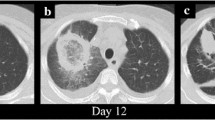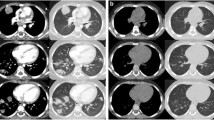Abstract
Opportunistic fungal infection is a rare but severe complication in allogeneic bone marrow transplant (BMT) recipients. We report a 49-year-old patient who developed pneumonitis after BMT, due to a Mucorales fungus (class Zygomycetes), Absidia corymbifera. Infections due to mucormycosis are likely to become increasingly recognized even though the occurrence after BMT has only been described sporadically. We postulate that the patient was contaminated before BMT despite no intensive drug treatment or other iatrogenic features, related to his poor living conditions and developed the infection during aplasia. He immediately received i.v. liposomal amphotericin B (AmBisome) and GM-CSF. Because there was no response, the infected area and necrotic tissue were resected. Despite initial clinical and biological improvement and the absence of Mucor on mycological examination post-surgery, the patient died 3 weeks later from bilateral pulmonary infection and multiorgan failure.
Similar content being viewed by others
Author information
Authors and Affiliations
Rights and permissions
About this article
Cite this article
Leleu, X., Sendid, B., Fruit, J. et al. Combined anti-fungal therapy and surgical resection as treatment of pulmonary zygomycosis in allogeneic bone marrow transplantation. Bone Marrow Transplant 24, 417–420 (1999). https://doi.org/10.1038/sj.bmt.1701898
Received:
Accepted:
Published:
Issue Date:
DOI: https://doi.org/10.1038/sj.bmt.1701898
- Springer Nature Limited
Keywords
This article is cited by
-
Rhino-Orbital-Cerebral Mucormycosis
Current Infectious Disease Reports (2012)




